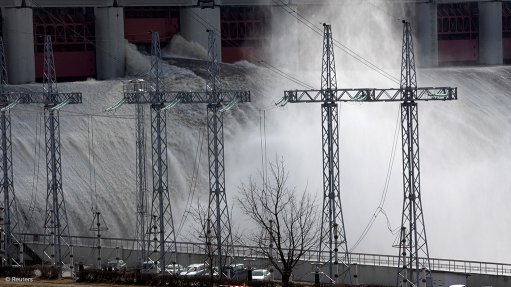
KEEPING ELECTRICITY FLOWING
Tembo Power has nine hydropower projects under way in three African countries, including the Democratic Republic of Congo, Burundi and Kenya
Photo by: Reuters
With delays from Covid-19 taken into consideration, Mauritian hydropower provider Tembo Power CEO Raphael Khalifa expects construction on three hydropower projects and one solar photovoltaic project, in the Democratic Republic of Congo (DRC), to have started by July next year.
These four renewable-energy projects will service the country’s mining industry with a total installed capacity of 96 MW when completed, with an estimated total construction cost of $273.76-million.
“We are raising $100-million for the equity of these projects, of which we will own 50% to 60%,” Khalifa revealed during a live webinar hosted last month as part of the DRC Mining Week conference.
He explained that Tembo Power had entered into an agreement with French contractor Eiffage to develop the projects, and that the two companies had collaborated to conduct geotechnical investigations last year. He noted that these investigations were completed earlier this year.
Currently, the collaboration is conducting “more detailed and bankable studies”.
Khalifa said all the necessary environmental licences were in place, but that concession agreements were still being finalised. Discussions are under way to secure and finalise power purchase agreements (PPAs).
Two of the three hydropower projects will have an installed capacity of 17 MW each, with the third having an installed capacity of 32 MW. Khalifa explained that an additional 30 MW solar photovoltaic project was added to the mix last year to “smooth” the power generation profile throughout the year for the mines being serviced.
The projects are all located in the Lubudi area of Lualaba province, which is part of the former Katanga province.
Lualaba province is situated on the Central African Copperbelt, which is where some of the world’s largest copper/cobalt mines and beneficiation facilities are located.
Two of the three hydropower projects will use existing weirs, which reduce construction costs as well as their respective environmental and social impacts. The projects are all about 10 km away from the 120 kV transmission line feeding the substation that dispatches power to many mining companies.
Other Projects
Tembo Power also has two hydropower projects under way in Burundi, and four in Kenya. Including the four projects in the DRC, the company is responsible for a total installed capacity of 190 MW, with Khalifa saying that the total investment cost amounts to about $500-million.
The two Burundi hydropower projects are located in south-western Burundi’s Rumonge and Bururi provinces, with an installed capacity of 9 MW and 11 MW respectively. This area is strategically important to the government of Burundi, with government previously stating its commitment to supporting private investment and economic development by providing stable and reliable power along the southern shores of Lake Tanganyika.
Burundi’s regulatory framework encourages private–public partnerships, as well as private production, transmission and distribution in the energy sector, in addition to providing a favourable platform to engage directly with the country’s national utility Regideso for PPAs.
Moreover, a pure independent power producer project financed transaction has been closed with the support of various development finance institutions.
The Burundi projects are at equal stages of development and are all on schedule to reach financial closure in 2021; these projects will contribute to the increase in Burundi’s total generation capacity. The estimated construction cost of the two projects combined amounts to $69.27-million.
Meanwhile, the four Kenyan hydropower projects are located in the western part of the country, an area where power generation is lacking and often supplied by costly diesel plants.
National power utility Kenya Power and Lighting says it is committed to replacing diesel with baseload hydropower, as it is less expensive and more sustainable. The aim is to reduce demand for diesel imports from Uganda, ultimately stabilising the grid using locally generated power.
Kaptis, the most developed of the four Kenyan projects, has equity and debt fully secured. The 15 MW project is expected to reach financial closure by the end of this year, according to Tembo Power’s website.
The other three Kenyan hydropower projects have installed capacities of 14 MW,
17 MW and 24 MW. They are in earlier stages of development but are on schedule to reach financial closure in 2022, pending optimisation studies. Tembo Power believes that these projects will benefit from the legal, regulatory, contractual and contracting work achieved on Kaptis.
The four Kenyan hydropower projects are estimated to cost about $192.6-million.